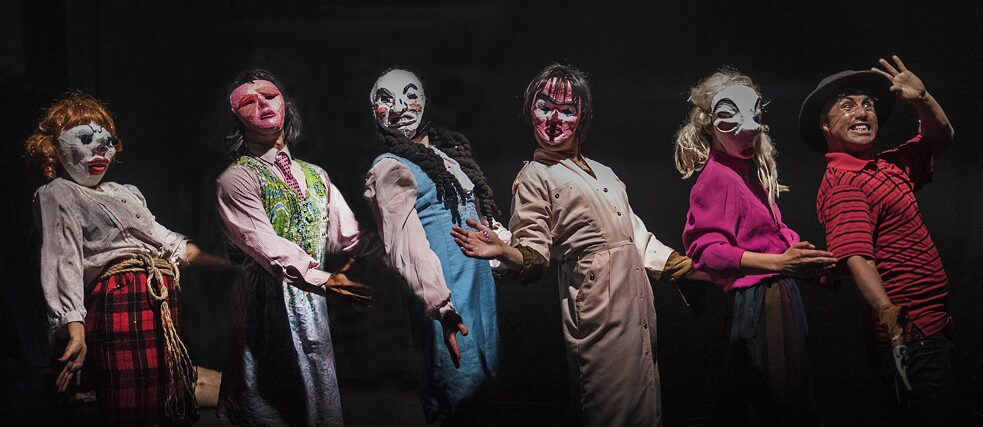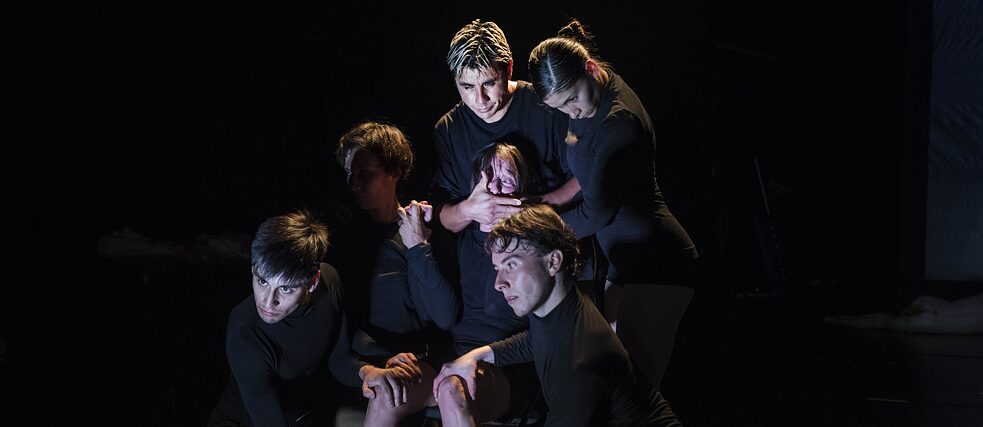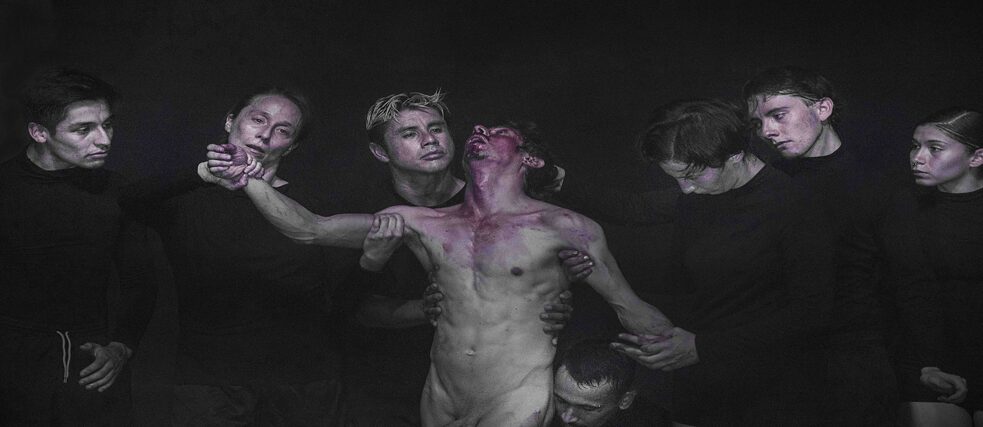Teatro La Re-Sentida, Santiago de Chile, Chile
About Origins and Mechanisms of Violence

Based on specific experiences of violence in Chile’s recent history, the play Oasis de la Impunidad was developed during a theatre laboratory at the Teatro La Re-Sentida in Santiago de Chile. Without many words, through the choreographic setting alone, the origins and mechanisms of violence are revealed and translated into immediate, haunting images.
Interview with Marco Layera, Elisa Lero and Martin Valdés-Stauber, the artistic director team of the play Oasis de la Impunidad
Can you start by introducing us to Teatro La Re-Sentida? What are the intentions of your theatre work?
The theatre collective was founded in 2008 by young theatre-makers from Chile with the aim of expressing the ideas, convictions and visions of their own generation in the theatre. Over the years, members of the core group have moved on and been replaced many times, and yet the initial structure of a collective working method around director Marco Layera continues unchanged.
The name la re-sentida translates as the resentful, and yet it is important to emphasise that the troupe doesn’t just criticise, but focuses on the political responsibility of theatre-making.
La Re-Sentida combines reflection with provocation while understanding theatre as an instrument of criticism, reflection and (re)construction. Thus, the plays don’t avoid critical self-questioning but cheekily and cleverly question their own certainties. Instead of conflating questions from the past and present, La Re-Sentida never shies away from contradictions. Moreover, with each project we embark on a new journey in search of a specific formal language.
Through you, Martin Valdés-Stauber, there is a connection between the Teatro La Re-Sentida and the Münchner Kammerspiele. What is the collaboration like?
MV-S: Even before the pandemic, a dialogue had developed between the Münchner Kammerspiele and La Re-Sentida. Together we wanted to reflect on what it means to work in international constellations. Previously, La Re-Sentida had mostly developed plays without being supported in this process by European partner institutions. From the moment of the premiere, however, their plays were important cornerstones of many festival programmes. The pandemic brought this international exchange to a complete standstill.
The Relief Fund of the Goethe-Institut and the German Foreign Office was essential to enable the group to survive the pandemic. The work in the theatre laboratory gave us the idea of thinking about a joint premiere: from the experiences of hundreds of workshop participants, we developed a concept for the play of the same name, Oasis de la Impunidad, which was produced by the artistic research area Memory as Work on the Present, which I have the privilege of directing at the Kammerspiele.
Having grown up bilingual, I’m happy to build bridges and facilitate translation processes at all levels. As a dramaturge, I’m excited about forging alliances that allow for an exciting and unique search for forms.
 Rehearsal of the Play: Oasis de la impunidad
| © Maglio Pérez, Teatro La Re-Sentida, Goethe Institut
Speaking of the theatre lab: You talk about an experimental set-up that will result in a play about violence. What interests you about this topic?
Rehearsal of the Play: Oasis de la impunidad
| © Maglio Pérez, Teatro La Re-Sentida, Goethe Institut
Speaking of the theatre lab: You talk about an experimental set-up that will result in a play about violence. What interests you about this topic?
Violence is a universal theme. And yet, in Chile in particular, there is a specific history of violence. It is precisely this kind of tension that usually lies at the origins of La Re-Sentida’s projects: Starting from a specific experience, a unique theatre world emerges that negotiates fundamental questions that affect us all. All the experiences that were shared in the theatre laboratory are crucial to this process. Impunity and violence in Chile are closely linked to Pinochet’s military dictatorship, but also to police brutality. We ask ourselves: How does a democracy negotiate dealing with its own state’s monopoly on violence?
What does the theme of violence have to do with the place, with the country, with Chile?
Violence is manifold and appears in many different forms. Classism, sexism and racism systemically and repeatedly lead to experiences of violence. As far as Chile is concerned, however, we must remember in particular the abductions and political murders during Pinochet’s military dictatorship. Two years ago, in 2019, the violence against protesters from civil society who stood up for their dignity at the estallido social and took to the streets for a truly democratic constitution was all the more frightening. For we mustn’t forget that the current constitution was enacted under Pinochet.
What are your intentions with the theatre lab as the basis for the play being developed?
Laboratories are spaces where we can experience experimentation. For theatre, this means that skills and personal knowledge are shared here in a playful way. In the sense of artistic research, the theatre laboratory is a place of learning (and unlearning), as well as creativity. In the process, knowledge is created. But perhaps this is knowledge that has long been present in us and our bodies, which we are now, together, simply bringing to light.
In October, we launched a call for as many people as possible to participate in the theatre lab. Part of the registration was a short questionnaire, which turned out to be very enriching as many people shared their own experiences of violence. In total, over 500 people signed up! We then invited around 200 people to the theatre lab. Occasionally we also brought in experts to work with the participants, for example on the choreography. In the end, a smaller group of about 20 people worked on a theatre sketch that we were able to present to a small audience on 20 January.
How do the performing arts relate to the theme of violence? What can a play do that is special compared to other artistic forms?
A crisis situation or mood (such as the estallido social) requires art to reinvent itself in order to participate in social processes. Art is challenged to (re)gain its subversive and transformative capacity. As artists, we are challenged to take a step into the unknown and the uncertain, to get lost, to take risks and to put ourselves in constant danger. For us, this meant facing the issue of violence with the means of theatre, but without words. The immediacy of theatre develops its own urgency in this choreographic setting.
In our current work, we thought a lot about systems of order: the state as the organising power of public space that disciplines bodies in order to enforce control ... but also the theatre as the disciplining place of bodies on a stage. Finally, we also thought of the stage as a disciplined place: as a museum space in which everything has its fixed place. How do bodies arrange themselves and when do they break out of the strict choreography?
In all our projects, the writing is done parallel to the experimental laboratory phase and the actual rehearsals. This time, however, the aim was not to develop a thick book at all, but to generate words and meaning primarily on completely different levels. Choreography and scenic images therefore come to the fore in this work.
 Rehearsal of the Play Oasis de la Impunidad, Teatro La Re-Sentida, March 2022
| © Maglio Pérez, Teatro La Re-Sentida, Goethe-Institut
We searched for and found a new artistic language in this process, which is both a break with and a continuation of our programme. Actually, we intend to develop a new artistic language with each project and in this case this language is choreographic. Presumably, however, the themes that are driving us are not new, as they are fed by our experiential space in Chile.
Rehearsal of the Play Oasis de la Impunidad, Teatro La Re-Sentida, March 2022
| © Maglio Pérez, Teatro La Re-Sentida, Goethe-Institut
We searched for and found a new artistic language in this process, which is both a break with and a continuation of our programme. Actually, we intend to develop a new artistic language with each project and in this case this language is choreographic. Presumably, however, the themes that are driving us are not new, as they are fed by our experiential space in Chile.
The intensive choreographic work of the past months will definitely continue to accompany us. In addition, for the first time we worked in a Chilean-European team, as the dramaturges Elisa Leroy and Martin Valdés-Stauber accompanied us from the basic conception to the premiere. Of course, we would like to repeat this intensive involvement with European colleagues in the rehearsal process itself in the future.
What will happen to the play then? Where will it be shown?
The play is premiering on a tour from Berlin via Munich back to Santiago de Chile, where the rehearsals took place. We are currently planning further guest performances in Europe (in the summer we will be at the Ruhrtriennale) and South America and would be happy if as many audiences as possible would join us in questioning the origins and mechanisms of violence. Audience discussions and workshops on the fringes of guest performances are therefore particularly important for us, especially for this work.